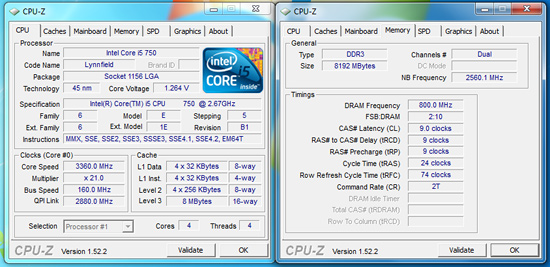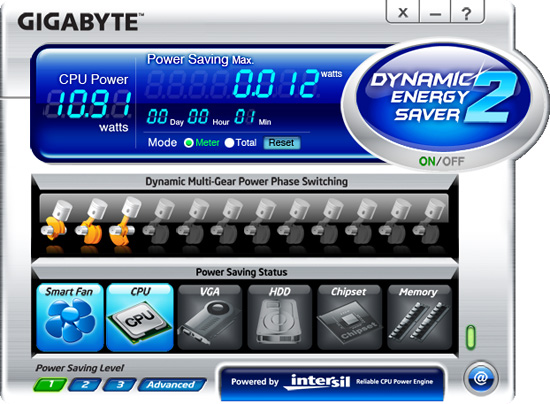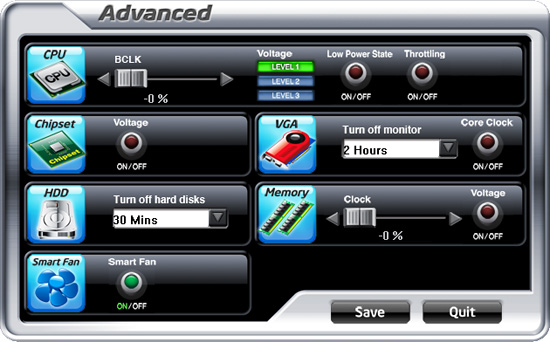Budget Micro-ATX P55 Faceoff: Gigabyte GA-P55M-UD2 and ASRock P55M Pro
by Gary Key on October 5, 2009 12:30 PM EST- Posted in
- Motherboards
Software
GIGABYTE provides several software applications with the GA-P55M-UD2, EasyTune6, D.E.S 2, and Smart 6 being the three main ones.
EasyTune6

GIGABYTE's EasyTune6 application provides monitoring, system information, and overclocking capabilities. This is one of the better applications provided by the various motherboard suppliers for tuning a system within Windows. We would still like to see additional voltage readings and the ability to save the settings to the BIOS - or at least a BIOS profile. The version shipped on the driver CD did not allow Bclk changes, but the updated version on the website works correctly.
We still prefer tuning within the BIOS. Other than that, this application is useful for extracting a decent amount of performance improvement out of the system after booting Windows. One benefit of such an approach is that you can reduce performance - along with power requirements and the stress on a system - without rebooting.

Quick Boost mode is a simple way for novice users to quickly overclock their systems without entering the BIOS. Once you click on one of the three boost levels, the utility will automatically optimize system settings according to your specific hardware combination. A reboot is required since this not an on-the-fly routine. The program is based on algorithms of hardware that has been pre-tested by GIGABYTE engineers unlike the MSI and ASUS offerings that evaluate your actual hardware configuration.

We tried around fifteen different hardware combinations and all worked correctly. Of course, it should work as the single core turbo mode on the i5/750 hits 3.2GHz without a problem, even when undervolting. Of course, with the Level 3 overclock, all four cores will be operating at 3.2GHz which comes in handy with video/audio encoding or 3D rendering programs. Although our memory kit was capable of C7 settings at DDR3-1600, at least this application set the board to DDR3-1600 speeds. Otherwise, the aggressive turbo modes on the Lynnfield processors have just about made this particular feature useless.

For those who appreciate and want a manual approach to overclocking, the Tuner tab has two different options. Easy mode allows control over Bclk, but it is Advance mode that opens several on-the-fly tweaking options that actually work. You can adjust Bclk, memory speed, PCI-E frequency, and numerous voltage options.
We have to say that using EasyTune6 was an almost painless experience although we prefer BIOS tuning on this platform. During the more extreme overclocking tests, this was the first application we loaded after getting the OS installation up and running. ET6 can be a huge help in tweaking those final settings to find a motherboard's overclocking limits.
DES 2

One of the most highly touted features from GIGABYTE is their Dynamic Energy Saver (DES 2) advanced power management solution. GIGABYTE provides a Windows-based software application to control DES 2. After installing the software (we highly recommend downloading the latest version) and a quick reboot, the application is ready for use. The control panel is powered down by default and it is up to the user to turn it on with a simple click of the DES button.

The DES software is simple to use and easy to understand. GIGABYTE provides a power savings meter in the top portion providing us with power savings information that can be reset at startup; otherwise it will track the power savings since the installation of the product. Real-time CPU power usage is available along with a graphic representation of the phases in use. You can also enable CPU throttling to save additional power during operation. The advanced tab lets you set power saving options for other peripherals, although we did not notice any additional power savings compared to Windows 7 default setup.
GIGABYTE also includes an onboard LED system that indicates the number of phases in use. These LEDs can be turned on and off from the control panel. The user can utilize DES while the system is overclocked although we typically did not measure any power savings in CPU bound applications, but games tended to respond well with a 3%~9% power savings.
Smart 6

Gigabyte also includes their new Smart6 software package that consists of Smart Quickboot, Smart Quickboost, Smart Recovery, Smart DualBIOS, Smart Recorder, and Smart Timelock. Smart Quickboot is a simple way to quickly set S3 sleep state in the BIOS and enable Hibernation in Windows. Smart Quickboost is the auto overclock application in ET6.
Smart Recovery is a method to quickly backup files or directories but not complete OS images. The unusual feature here is that even reformatting the drive will retain this hidden partition and data. We tried, it works. Smart DualBIOS is a personal recorder for saving important dates or password in the BIOS. Even if you lose this information in the OS, it is still retained. The downside is that reflashing the BIOS wipes the data clean. SmartRecorder is basically a time logging program to track access times and monitor file changes. Smart Timelock is a software application that can lockout a PC user for a certain period of time, but the time period considers a day to be only eight hours.
















55 Comments
View All Comments
mfs - Friday, March 26, 2010 - link
how do you get 4 phase on the GA-P55M-UD2? looks like 6 by the photos? bit-tech says 6 too.andersbranderud - Friday, March 12, 2010 - link
Does anyone have any experiences with overclocking an i7-860 on this motherboard with 1333 mhz or 1600 mhz ram.In that case give me some more details.
Thanks!
Anders Branderud
bloganders.blogspot.com
zoggy - Thursday, February 18, 2010 - link
Was looking at picking up GA-P55M-UD2 for a HTPC, going to pair it with Core i7 860 and a ATI HD 5000 series card. Wanted to know if there was any problems with this board to do the bit-streaming of HD audio or if the UD4 would be better suited?Hrel - Friday, October 23, 2009 - link
Pictures of the Motherboard BIOS, THANK YOU SO MUCH!maomao0000 - Sunday, October 11, 2009 - link
http://www.myyshop.com">http://www.myyshop.comQuality is our Dignity; Service is our Lift.
Myyshop.com commodity is credit guarantee, you can rest assured of purchase, myyshop will
provide service for you all, welcome to myyshop.com
Air Jordan 7 Retro Size 10 Blk/Red Raptor - $34
100% Authentic Brand New in Box DS Air Jordan 7 Retro Raptor colorway
Never Worn, only been tried on the day I bought them back in 2002
$35Firm; no trades
http://www.myyshop.com/productlist.asp?id=s14">http://www.myyshop.com/productlist.asp?id=s14 (Jordan)
http://www.myyshop.com/productlist.asp?id=s29">http://www.myyshop.com/productlist.asp?id=s29 (Nike shox)
Googer - Sunday, October 11, 2009 - link
I don't see how the inclusion of something can be seen as a negative. I am sure there are a few users who still depend on a floppy drive from time to time (retro dos gamers, some drivers, and archiving old files) and it's presence has little to negative impact on the actual usability, functionality, or performance of the motherboard.As for my self, I have tried several times to remove my drive, only to have someone or myself find an unexpected need for it a few months later. So I still keep it installed but the drive it's self remains disabled in the bios until I actually need it. Having it enabled has no noticeable impact on my P4 based system.
Serveo - Friday, October 9, 2009 - link
Hi Gary,Nice review. I am planning to buy a p55 mATX board. There are some on the market but mostly they support only 16x & 4x GPU and thats a pity.
Only the Gigabyte GA-P55M-UD4 and ASUS Maximus III Gene support sli/cross at 8x mode. I would like to your review about these boards soon. The price for the GA-P55M-UD4 is available around € 130.- incl. VAT and the Maximus III Gene around € 170.- incl VAT.
Thats why I probably go for the Gigabyte due to the price an the board colors, but the board layout has some fails and according to the review at bit-tech.net the performance is not that good.
Gary when can I aspect the review about these boards? Or which of these two board would you advice?
Awnold - Wednesday, October 7, 2009 - link
Hi Gary,Great article! Looking at other user's experience w/ the Gigabyte board, I've seen a number of complaints w/ memory compatibility (e.g., Newegg's reviews). Would you mind posting the part #'s of the different memories you tested this board with?
I did see your comment that the F4 BIOS improved memory compatibility, but to my knowledge they haven't updated their qualified memory list yet.
Also, if other users on this forum have experience w/ this board, would you mind posting your memory config as well?
Thanks!
Awnold - Friday, October 9, 2009 - link
I'm mostly curious about the G.Skill memory used. Does anyone have any success (or BSODs/failures) with the following modules:F3-12800CL7D-4GBRH
F3-15000CL9D-4GBRH
F3-16000CL9D-4GBRH
haplo602 - Tuesday, October 6, 2009 - link
stop with this P55 flood and finaly review a few 785G boards !!! please please PLEASE !!!I don't care about intel, I want to build an AMD PC and your site is severely lacking in that part ...